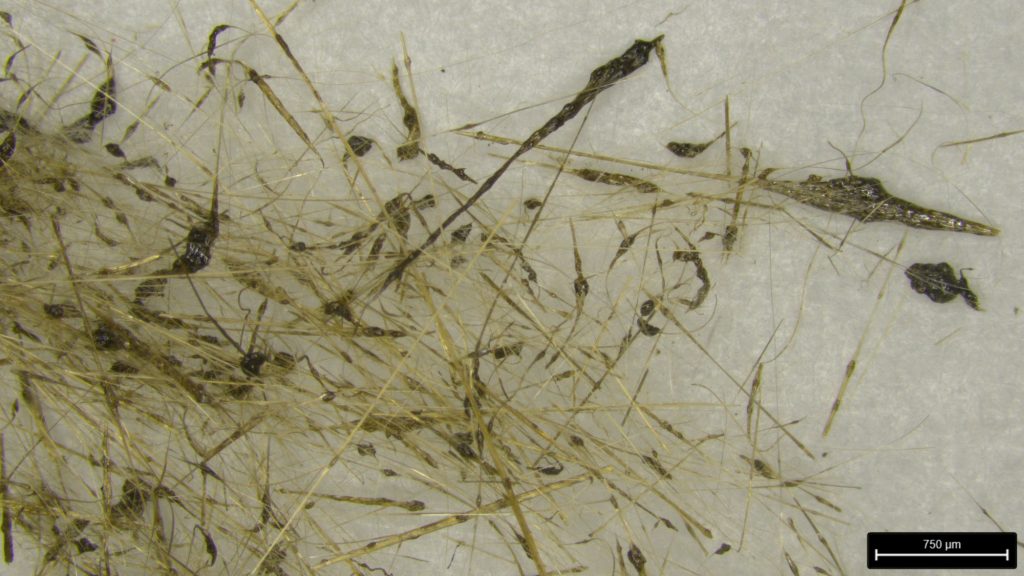Volcano Watch: Pele’s hairs — a beautiful hazard on the Island of Hawaiʻi
Volcano Watch is a weekly article and activity update written by scientists and affiliates with the U.S. Geological Survey Hawaiian Volcano Observatory. Today’s article is by Jo Schmith of the Center for the Study of Active Volcanoes.
Shiny and elusive, featherlight and golden brown. If poets were to write about rocks, I’m sure they would sing their praises of Pele’s hairs. Don’t be fooled. Pele’s hairs are strands of volcanic glass, and they can pose a serious hazard.

The fragile hairs easily break into tiny pieces, and no one wants glass splinters in their eyes or skin that just keep breaking when you try to pull them out. So, leave the hairs be if you find them.
Pele’s hairs can be more than 3 feet long and are often less than 0.04 inches thick. During the recent Mauna Loa eruption in November and December 2022, Hawaiian Volcano Observatory scientists went to explore the Daniel K. Inouye Highway (Saddle Road) for erupted material. Along the sides of the road, they saw strands up to 20 inches long, as well as clumps of entangled hairs. Observant residents and visitors saw them on the ground at the Mauna Kea visitor center and all the way to Honokaʻa, reporting their findings to the Hawaiian Volcano Observatory. We were glad they did.
Pele’s hairs form when molten lava is torn apart. Like the thinning strings that form when you pull your hands away from sticky dough, the hair strands form when blobs of lava are torn apart and the fluid lava still connecting them is stretched thin. The outer skin of the lava is cooled quickly by the air and forms volcanic glass that freezes this fragile moment in time. However, if the skin is cooled too quickly before it is stretched thin, it will break into glass pieces instead. If the lava is too sticky, it cannot be stretched enough to form hairs.
That is why Pele’s hairs only form on basaltic volcanoes that produce fluid lava like in Hawaiʻi. However, if the melted rock is too fluid, it will behave more like water and form droplets instead. In Hawaiʻi those are known as Pele’s tears. The same is true if the air is too hot and doesn’t cool the skin fast enough. If pulled apart too quickly the lava will not have enough time to stretch, and again it will break into pieces. So, Pele’s hairs only form under very specific conditions, and the best conditions are in vigorous Hawaiian lava fountains or in bubbling lava lakes.
Scientifically, Pele’s hairs are part of the tephra family that includes all solid particles flying out of a volcanic vent. The most common way to classify tephra is by grain size. For example, ash is defined as tephra particles smaller than 0.079 inches, and lapilli is defined as tephra particles between 0.079 to 2.52 inches. The largest tephra particles have two names. Tephra particles above 2.52 inches are called bombs if they are made from the freshly erupting magma, but they are called blocks if they are made from preexisting rocks blasted by more explosive activity.

But what about Pele’s hairs? It seems a bit of a stretch (pun intended) to call them “bombs” even though they are often more than 2.52 inches long. Bombs or blocks typically fall in the area close to the vent and pose a significant hazard in that area. In 1924 a photographer that ventured too close to the explosions from Kīlauea’s Halema‘uma‘u crater was fatally injured by a falling block. Pele’s hairs falling on you would not do that. Instead, they travel with the wind like ash.
Pele’s hairs can spread far and are a regional hazard like ash particles, though the long bendy stands don’t have the same aerodynamic properties as tiny pieces of ash. This becomes a problem when trying to forecast their whereabouts using tephra dispersal models, so to classify them as ash also makes little sense.
Perhaps Pele’s hairs are just unique. What other type of rock can curl up in mangled balls yet shatter from “bomb-size” to “ash-size” within a second? So, make sure to appreciate these fascinating glass strands if you see them, but watch with care.
Volcano Activity Updates
Kīlauea is no longer erupting. Its USGS Volcano Alert level is ADVISORY. Kīlauea updates are issued daily.
Webcams show no signs of lava activity in Halemaʻumaʻu crater, at the summit of Kīlauea in Hawai‘i Volcanoes National Park. Summit tiltmeters have shown multiple deflation-inflation events over the past week. Seismicity is low. The sulfur dioxide (SO2) emission rate was most recently measured on February 28, when it totaled approximately 250 tonnes per day. For Kīlauea monitoring data, see https://www.usgs.gov/volcanoes/kilauea/past-week-monitoring-data-kilauea.
Mauna Loa is not erupting. Its USGS Volcano Alert Level is at NORMAL. Mauna Loa updates are issued on the first Thursday of the month.
Webcams show no signs of activity on Mauna Loa. Seismicity remains low. Deformation rates show inflation somewhat above background levels, but this is not uncommon following eruptions. SO2 emission rates are at background levels. For Mauna Loa monitoring data, see https://www.usgs.gov/volcanoes/mauna-loa/monitoring-data.
There were two earthquakes with 3 or more felt reports in the Hawaiian Islands during the past week: a M2.6 earthquake 21 km (13 mi) SSE of Waimea at 21 km (13 mi) depth on March 17 at 11:22 p.m. HST, and a M3.0 earthquake 3 km (1 mi) SW of Pāhala at 35 km (22 mi) depth on March 20 at 6:26 a.m. HST.
HVO continues to closely monitor Kīlauea and Mauna Loa.
Visit HVO’s website for past Volcano Watch articles, Kīlauea and Mauna Loa updates, volcano photos, maps, recent earthquake info and more. Email questions to askHVO@usgs.gov.
Sponsored Content
Comments








